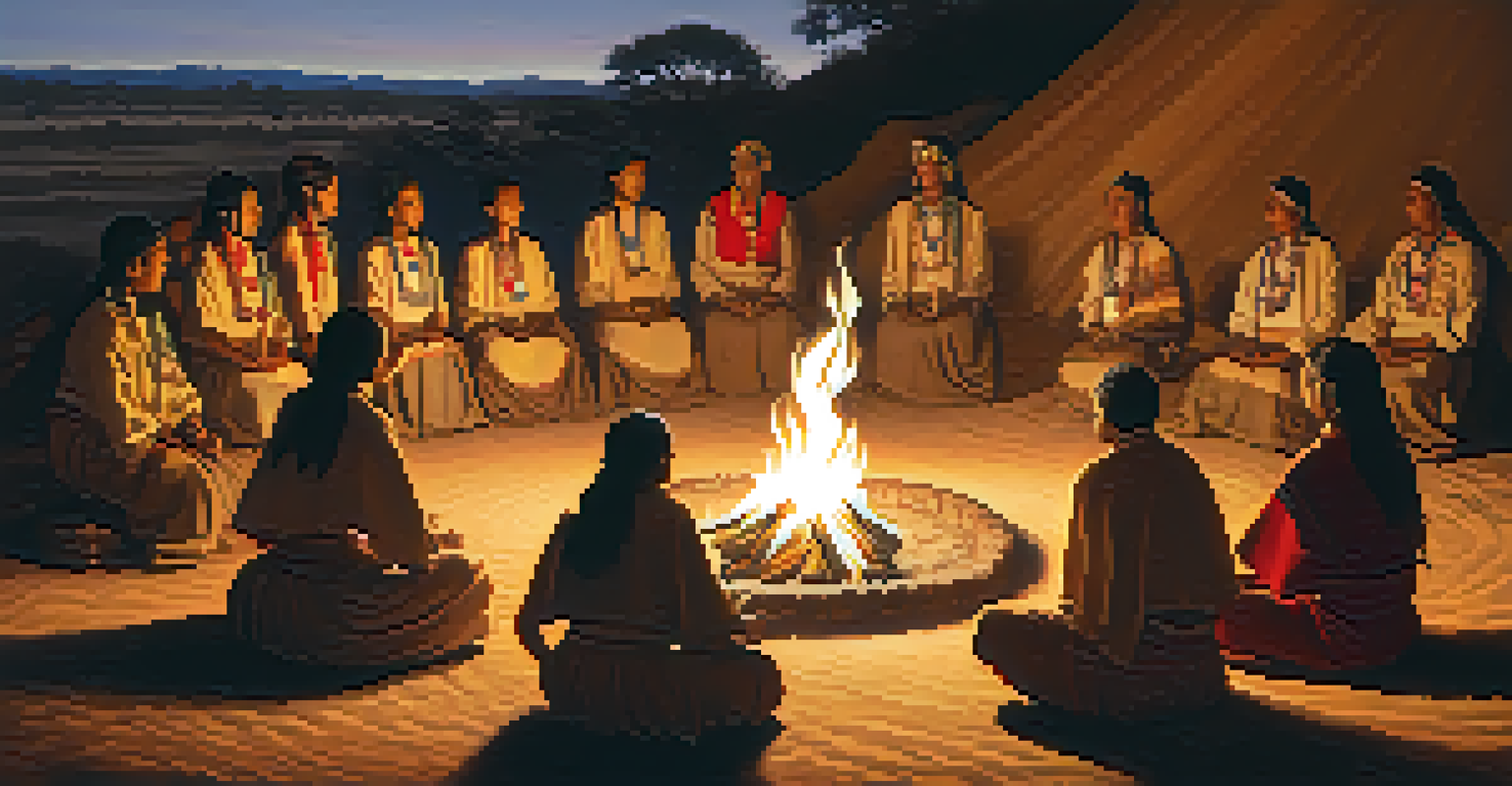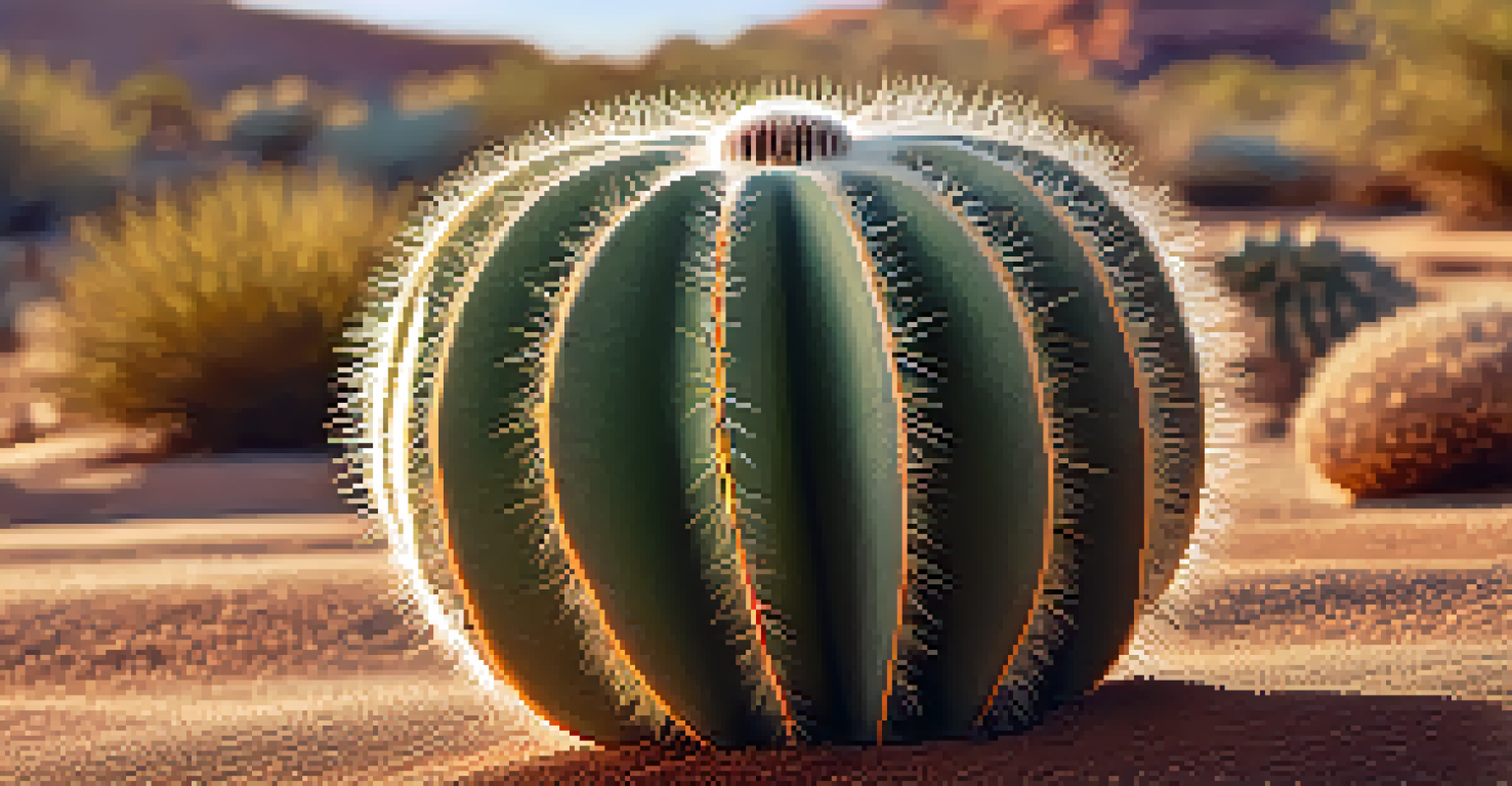Psychoactive Properties of Peyote in Indigenous Traditions

Understanding Peyote: A Brief Overview
Peyote, a small cactus native to North America, has been a key component in various indigenous cultures. Known scientifically as Lophophora williamsii, its psychoactive properties are mainly attributed to mescaline, a compound that influences perception and consciousness. For centuries, Native American tribes have revered peyote, integrating it into their spiritual practices and rituals.
The use of peyote in ceremonies is a profound journey that connects the physical and spiritual realms.
The cultivation and harvesting of peyote are deeply rooted in tradition. Indigenous peoples often view the cactus as a sacred plant, symbolizing life, healing, and enlightenment. This reverence is not just about the plant itself but also about the experiences and insights it offers during ceremonial use.
In many ways, peyote acts as a bridge between the physical and spiritual realms, allowing individuals to explore profound aspects of their existence. Understanding its role within these cultures requires a respect for their history and beliefs surrounding this powerful plant.
The Role of Peyote in Indigenous Spiritual Practices
Peyote is often consumed during religious ceremonies, where it serves as a catalyst for spiritual awakening and community bonding. These gatherings provide a space for participants to share their experiences, fostering a sense of unity and collective healing. The use of peyote in these contexts is guided by traditional knowledge passed down through generations.

One notable ceremony is the Native American Church's peyote meeting, which blends Christian elements with indigenous practices. Participants engage in song, prayer, and sharing, allowing the effects of peyote to guide their spiritual journey. Such rituals exemplify how peyote can facilitate deep connections with oneself and with others.
Peyote's Role in Indigenous Culture
Peyote is a sacred plant integral to the spiritual practices and identity of many indigenous communities.
Through these practices, peyote helps individuals confront personal challenges and find clarity. The insights gained during these experiences can lead to transformative changes, reinforcing the idea that the plant is more than just a psychoactive substance; it is a sacred teacher.
Psychoactive Effects of Mescaline
Mescaline, the primary psychoactive compound in peyote, alters perception and can induce vivid visual and auditory hallucinations. Users often report experiencing an intensified awareness of their surroundings, leading to a heightened appreciation of nature and life. These effects can vary widely from person to person, influenced by factors such as mindset and environment.
Peyote is not just a plant; it is a sacred teacher that guides individuals on their spiritual path.
Many individuals describe feelings of euphoria, deep introspection, and an overwhelming sense of connectedness with the universe during their peyote experiences. This altered state can provide profound insights, often described as life-changing. However, it is essential to approach these experiences with respect and intention.
While the psychoactive effects of mescaline can be enlightening, they also carry potential risks, especially outside of a ceremonial context. Misuse can lead to uncomfortable psychological experiences, underscoring the importance of guided use within established traditions.
Cultural Significance of Peyote in Indigenous Identity
For many indigenous groups, peyote is emblematic of their cultural heritage and identity. The plant is interwoven with their history, spirituality, and community practices, embodying values that have been sustained over centuries. As a result, the use of peyote is often seen as a form of resistance against cultural assimilation.
Participation in peyote ceremonies reaffirms a communal identity, allowing individuals to connect with their roots and ancestors. This shared experience fosters resilience and continuity, as younger generations learn the importance of their cultural practices through direct engagement.
Psychoactive Effects of Mescaline
Mescaline, the active compound in peyote, induces profound experiences that can lead to personal insights and community bonding.
Moreover, the act of consuming peyote is considered a sacred duty, reinforcing a collective commitment to preserving their traditions. In this way, peyote serves not only as a tool for personal exploration but also as a powerful symbol of cultural pride and survival.
Contemporary Issues Surrounding Peyote Use
Despite its cultural significance, peyote faces threats from overharvesting and habitat loss, raising concerns about its sustainability. As demand for peyote grows, particularly among non-indigenous users, the delicate balance of its ecosystem is jeopardized. This situation poses a challenge for indigenous communities that rely on peyote for their spiritual practices.
Additionally, the legal status of peyote varies widely, complicating its use for indigenous peoples. While some laws protect its use in religious contexts, others impose restrictions that can hinder access for tribes. This inconsistency can create tension between cultural practices and legal frameworks.
Advocacy for the preservation of peyote is crucial, as it not only protects the plant but also the traditions and identities of indigenous cultures. Efforts to raise awareness about its significance and promote sustainable practices are essential for ensuring that peyote remains available for future generations.
The Future of Peyote in Indigenous Traditions
Looking ahead, the future of peyote relies heavily on the commitment of both indigenous communities and broader society to respect and protect this sacred cactus. Engaging in conversations about sustainability and cultural preservation is vital for fostering understanding and cooperation. By acknowledging the importance of peyote in indigenous traditions, we can work together to safeguard its legacy.
Education plays a pivotal role in this endeavor, as increased awareness can lead to more responsible use and conservation efforts. Initiatives that involve indigenous voices in discussions about peyote can help ensure that cultural practices are honored and respected. This collaborative approach can strengthen the bond between indigenous peoples and their allies.
Challenges Facing Peyote's Future
The sustainability of peyote is threatened by overharvesting and legal restrictions, necessitating advocacy for its preservation.
Ultimately, the continued relevance of peyote within indigenous cultures depends on mutual respect and a commitment to preserving the wisdom it embodies. By honoring its place in spiritual traditions, we can help secure a future where peyote thrives, both ecologically and culturally.
Conclusion: Honoring the Legacy of Peyote
Peyote is much more than a psychoactive substance; it represents a rich tapestry of cultural heritage and spiritual exploration. Its significance in indigenous traditions highlights the intricate relationship between humans and the natural world, inviting us to reflect on our own connections. As we continue to learn about and respect these practices, we open ourselves to a deeper understanding of the human experience.
By embracing the lessons offered by peyote, we can cultivate a sense of appreciation for the diverse ways in which different cultures engage with the world around them. This journey encourages us to honor the wisdom of indigenous peoples and recognize the importance of preserving their traditions.

In conclusion, peyote serves as a reminder of the profound insights that can be gained through respectful exploration of altered states of consciousness. As we navigate our own paths, let us approach such experiences with reverence, ensuring that the legacy of peyote and its cultural significance endure for generations to come.